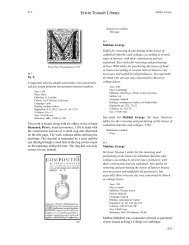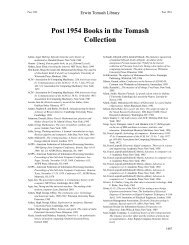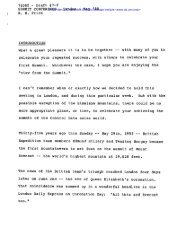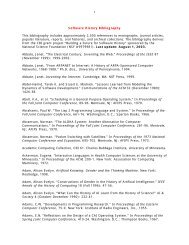B chapter.indd - Charles Babbage Institute - University of Minnesota
B chapter.indd - Charles Babbage Institute - University of Minnesota
B chapter.indd - Charles Babbage Institute - University of Minnesota
You also want an ePaper? Increase the reach of your titles
YUMPU automatically turns print PDFs into web optimized ePapers that Google loves.
230<br />
Erwin Tomash Library<br />
Bush, Vannevar Bush, Vannevar<br />
Bush covers mechanical (including his own differential<br />
analyzer), electrical and optical devices.<br />
Illustrations available:<br />
None<br />
B 301<br />
Bush, Vannevar E. (1890–1974)<br />
Science. The endless frontier. A report to the President<br />
Year: 1945<br />
Place: Washington, D.C.<br />
Publisher: USGPO<br />
Edition: 1st<br />
Language: English<br />
Binding: original paper wrappers<br />
Pagination: pp. x, 184<br />
Size: 230x150 mm<br />
This report was produced by Vannevar Bush, director <strong>of</strong><br />
the Office <strong>of</strong> Scientific Research and Development, at<br />
the end <strong>of</strong> the war. World War II had stimulated a huge<br />
leap forward in science and technology, and President<br />
Roosevelt had asked Bush to prepare a report on how<br />
best to release scientific information developed as part<br />
<strong>of</strong> secret military programs. In addition, he was to<br />
make recommendations about medical research, how to<br />
further research in the private sector, and how to develop<br />
a program to find and train the best scientific talent<br />
among American youth. One <strong>of</strong> Bush’s most influential<br />
recommendations was to establish a National Research<br />
Foundation to fund research in American universities<br />
and other institutions.<br />
Illustrations available:<br />
Title page<br />
[Bush, Vannevar E.]<br />
See Zernike, F.; De differentiaal-analysator als<br />
vorbeeld van een continue machine, 1949.<br />
B 302<br />
Bush, Vannevar E. (1890–1974) and Harold Locke<br />
Hazen (1901–1980)<br />
Integraph solution <strong>of</strong> differential equations. In Journal<br />
<strong>of</strong> the Franklin <strong>Institute</strong>, Vol. 204, No. 5, November<br />
1927<br />
Year: 1927<br />
Place: Philadelphia<br />
Publisher: Franklin <strong>Institute</strong><br />
Edition: 1st<br />
Language: English<br />
Binding: entire volume<br />
Pagination: pp. 575–615<br />
Size: 234x156 mm<br />
The Bush integraph was the precursor to his much more<br />
famous differential analyzer, announced in the pages<br />
<strong>of</strong> this same journal in 1931 (see entry for Bush, The<br />
differential analyzer, 1931). This integraph contained<br />
two stages <strong>of</strong> integration, allowing the solution <strong>of</strong><br />
second-order differential equations: the first integrator<br />
is a Thompson direct-current integrating watt-hour<br />
meter; the second the more familiar Kelvin, wheel-disk,<br />
mechanical integrating device. Having not yet developed<br />
his torque amplifier (used in the Differential Analyzer),<br />
Bush used servo-motors controlled by relays actuated<br />
by contacts on the integrators to power the rest <strong>of</strong> the<br />
system.<br />
Illustrations available:<br />
First page<br />
General view <strong>of</strong> the integraph<br />
Disk-Wheel integrator<br />
B 301 Disk-wheel integrator, B 302







